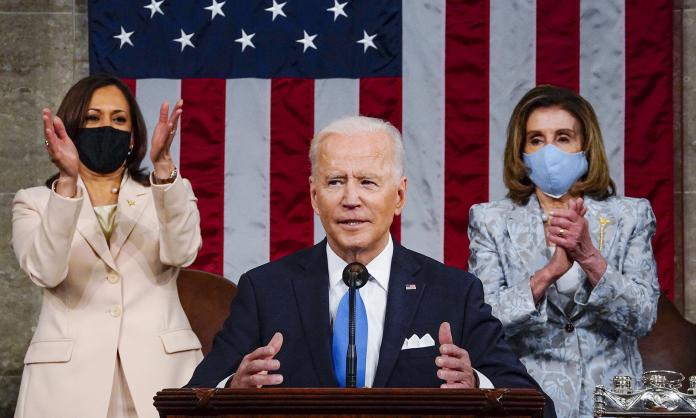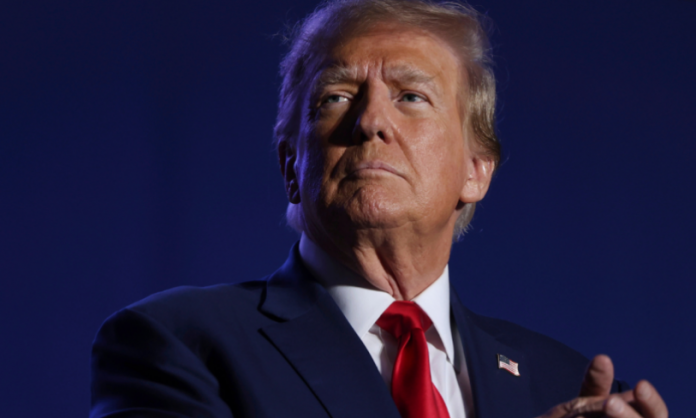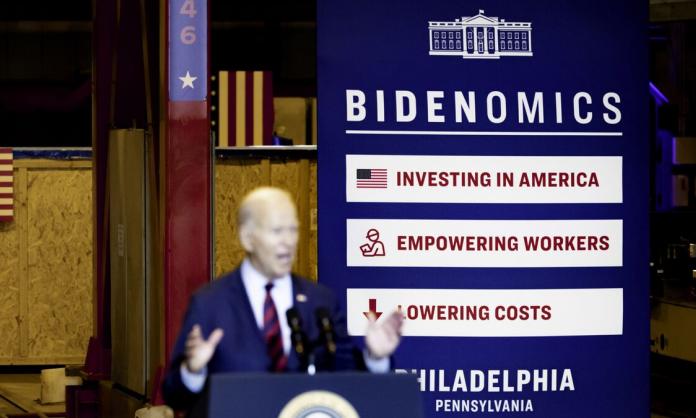When Joe Biden addressed Congress to mark his first 100 days as president of the United States, he probably didn’t need to say much to get a rapturous reception from the global media. It’s not that long since he vanquished Donald Trump, guaranteeing himself a place in the pantheon of mainstream liberal heroes. (On the day of Biden’s inauguration, before he’d done anything at all, ABC’s Byron Pitts breathlessly declared him “papa-in-chief”.) But despite the low bar, Biden did say something unusual. His speech marked a shift for the longstanding right-wing Democrat, who pledged to his rich donors in 2019 that “nothing would fundamentally change” if he were elected.
Now the word of the day for the Biden presidency is “transformational”. Biden has gone “from transitional to transformational”, said the US News and World Report. Samuel Moyn in the New Yorker described the speech as a “breathtakingly ambitious set of proposals to use government as an instrument of social and economic transformation”. “This is a big break, and a mighty gamble”, wrote Jon Sopel for the BBC.
What’s the big break? For 40 years in the West, there has been a taboo around the idea of redistribution of wealth, direct government spending on services and infrastructure, and any open acknowledgment of the limitations of the market to deliver social outcomes. Of course, every country has redistributed wealth and spent money: it is impossible to maintain a complex capitalist society without taxes and spending. But corporate and top marginal income tax rates have tended downwards, services have tended to be privatised, and arguments for anything different have tended to come from the fringes of politics. That taboo was particularly pronounced in the United States, where even Barack Obama’s bank bailouts and deals with the private health insurance industry were denounced as “socialism”.
So it is significant that Biden’s speech takes a different tack. It goes well beyond the usual Democrat posturing about fairness, a good balance between the public and private sector, and exciting blue-collar jobs in new industries—all of which could be heard in any episode of the West Wing. Biden made a firm case for direct government spending on big projects—“investments that only the government was in a position to make”. In passages that sounded like they had been lifted from Bernie Sanders’ stump speeches, he discussed inequality in more combative terms than he is historically known for: “Twenty million Americans lost their job in the pandemic, working- and middle-class Americans. At the same time, roughly 650 billionaires in America saw their net worth increase by more than $1 trillion, in the same exact period”. Seemingly renouncing the framework that has defined his entire career in the mainstream of the Democrats, he said: “Trickle-down economics has never worked”.
It certainly is unusual to hear these points made by a sitting president of the United States, let alone one known for what is now called “centrism”, meaning a slavish devotion to the pro-market orthodoxy of US politics. Biden is arguing for a direction shift: for taxes on the rich to increase, rather than keep declining; for some redistribution into services such as childcare and education; for some more direct spending, alongside the familiar subsidies to the private sector. It’s easy to see the shift in direction, particularly on questions like the tax rate. Taxes on the super-wealthy have been falling; Biden wants them to increase.
That’s a change in direction. But it’s not travelling very far. Biden wants the highest income tax bracket to go up from 37 percent to 39.6 percent—which it was prior to tax cuts in 2017. The corporate tax rate would go up to 28 percent, with some new measures against tax avoidance. That would still make the corporate tax rate lower than it was before Donald Trump cut it from 35 percent to 21 percent, meaning that Biden’s “transformational” plan retains a big chunk of Trump’s corporate tax cuts. Similarly, many of the redistributive measures are temporary emergency spending and small cash payments—hardly enough to fundamentally transform a society that is rotting from within due to its long-term tolerance of extreme poverty amid plenty. They are a “pop-up welfare state”, not a permanent one, as Eric Levitz writes in New York magazine. “The upshot of the March 2020 CARES Act, with its $4.5 trillion cushion for the corporations, was to underwrite what economist Nouriel Roubini has called a K-shaped recovery—soaring asset prices, lengthening queues at foodbanks”, Susan Watkins writes in New Left Review. “The Biden recovery plans lift the bottom leg of the K by an inch or so.”
It’s too early to know if this movement reflects the early stages of a deeper shift, or if this will be the limit of the “transformational” approach. That hasn’t stopped the liberal wing of the Democrats from swooning over it. (“We cannot stop until it’s done”, raved Alexandria Ocasio-Cortez.) But from Biden’s speech, we can get a sense of why this shift might be taking place—and it doesn’t mean good news for the workers of the world. Biden outlined two reasons to find a new role for the US government in the economy, both arguments that might equally have come either from Bernie Sanders or Donald Trump.
First, US politicians can’t be seen as totally indifferent to the suffering of the poor because that would undermine the population's loyalty to the political establishment. And second, the US must thoroughly crush its rising rival, China—and that requires both a unified nation and a powerful economy that can keep up with its rivals in the world market and in war. Biden’s speech wasn’t a call for equality and fairness. It was a call for national unity in the face of a nuclear-armed rival.
Why should the US invest in its infrastructure? Because, Biden said, “We’re in competition with China and other countries to win the twenty-first century”. Why should the US renew and upgrade its investment in high-tech research? Because “China and other countries are closing in fast. We have to develop and dominate the products and technologies of the future”. Why should rival politicians accept Biden’s plan? Because “we can’t be so busy competing with one another that we forget the competition that we have with the rest of the world”.
Biden then turned to the threat posed by Xi Jinping. Why should the US try to restore its fraying political order, and spend a bit of money cooling down the resentments that led to the rise of Trump? Because Xi Jinping “and others, autocrats, think that democracy can’t compete in the twenty-first century with autocracies, because it takes too long to get consensus”. The leading role of “democracy”—meaning the US’s authority in the world system—must be restored, and that’s going to cost a bit. Because, as Biden kept warning Congress, “the rest of the world is not waiting for us”.
In fact, Biden’s plan in many ways reflects the culmination of Trump’s argument: we must rebuild US manufacturing specifically, and national unity generally, to take on China—even if that irritates some wealthy elites. Trump couldn’t implement that program: he was too strange and chaotic to be a unifying figure, and too beholden to tax-cutting Republicans to implement the strange vision of right-wing populism favoured by his early advisers.
But Trump’s position reflected a logical argument for the US establishment. US presidents have to navigate two tasks at once: cohering their enormous, unequal, conflict-ridden country, and dominating the world. Biden’s speech aimed to achieve both. If he's successful, it will represent a triumph for the US capitalist class, not for the oppressed. That he adopted some of the language of Black Lives Matter and Bernie Sanders should blind nobody to the fact that he is proposing a strategy for rebuilding the cohesion, prestige, and fighting capacity of the most destructive imperialist power the world has ever known.










